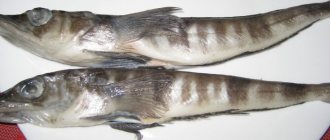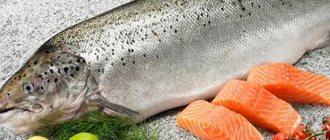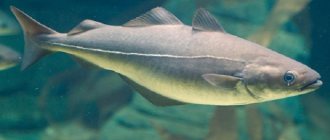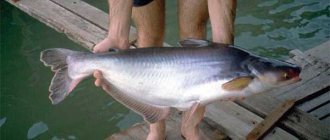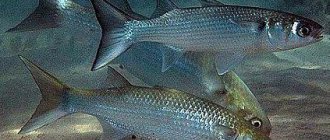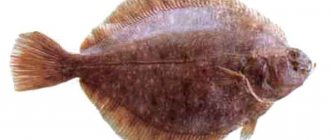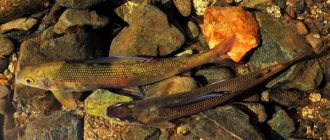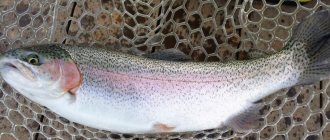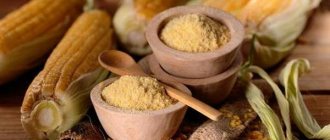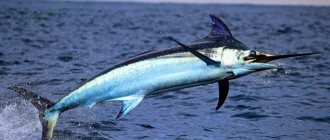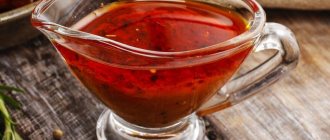Hoki or grenadier is a representative of cod marine fish. Another name for it is grenadier. Valued for its taste, it is considered a delicacy and is used to prepare fish burgers at McDonald's. Macrurus lives at great depths from 50 to 250 meters, where the water temperature is very low. It lives mainly in the Sea of Okhotsk and in the northern latitudes of the Atlantic and Pacific Oceans. The fish is considered “wild” and is not grown in artificial reservoirs.
Commercial catch
Adult
This is how it is delivered to the CIS countries.
Frozen fillet
Hokie burger at McDonald's
Frozen hoki carcass
Recipes from hoki (grenadier, grenadier)
The main commercial catch occurs in the New Zealand area. Carcasses are frozen and shipped all over the world. The Hoki has a large, elongated body with sharp scales, a long tail and bulging eyes. A distinctive feature is a dark spot behind the head; after catching, the color acquires red shades. The fish reaches 6 kilograms in weight and one and a half meters in length, but there are also larger specimens. The nutritional properties of grenadier, its benefits and preparation methods are described in the article below.
Useful properties of hoki
The introduction of grenadier into the diet allows you to:
- Saturate your body with animal proteins.
- Balance the menu in terms of energy value, since fish is a low-fat product. Fillet is well suited for dietary nutrition when losing weight.
- Improve the functioning of the digestive organs. The composition includes substances that provoke the activation of gastric juice. The product is easily digestible and is recommended by nutritionists for gastroenterological diseases.
- Strengthen the bone skeleton. This is facilitated by fluorine and calcium present in fish. Regular consumption of grenadier reduces the risk of osteochondrosis, rickets and oral problems.
- Replenish your supply of vitamins. With the help of hoki, you can protect the body from vitamin deficiency, restore strength after active physical activity or in the postoperative period.
- Resist the development of cardiac diseases, strengthen the heart muscle and improve heart function.
- Speed up metabolic processes, reduce the possibility of neuroses and depression, improve sleep.
- Strengthen the immune system, successfully resist the development of infectious diseases or damage to the body by parasites.
- Normalize thyroid function due to the high iodine content.
- Improve the functioning of the visual apparatus and increase its sharpness.
- Reduce blood pressure and improve hypertension, as khokie contains potassium.
- Improve the flow of blood through parts of the brain, develop mental abilities and memory.
- Remove toxic substances, heavy metal residues and excess cholesterol from the body.
- Stabilize the functioning of the hematopoietic system.
- Prevent the formation of cancerous tumors, since grenadier is a powerful antioxidant that eliminates the effect of free radicals.
- Slow down the aging process - restore the condition of the skin, strengthen the hair follicles and nails, and give the appearance a well-groomed appearance.
Hoki fish /
Recipe for Hoki fish baked under a vegetable coat
Products that I needed to prepare Hoki fish:
2 Hoki carcasses, 2 small tomatoes (I took very ripe ones), 1 bell pepper (medium size), 1 onion (quite large), 1 spoon of mayonnaise, 2 processed cheese, 1 teaspoon butter (to grease the pan), salt, pepper and spices as much as you want.
The carcass of the Hoki fish looks like pollock, but the Hoki's fins are small and are located along the entire body on the upper and lower sides. The fins are easy to cut; I cut them directly from a still frozen fish. Then I washed the hoki fish and cut it into two halves along the body. I would like to note that this fish has very few bones. There is a thick bone that is the spine of the fish and several small bones along the abdomen. I did not remove the bones and baked with them, but if you wish, you can easily remove the thick back bone, and small ones too.
And then I salted and peppered the halves of the hoki fish carcasses, sprinkled them with fish spices and placed them in a greased frying pan. And then I prepared the vegetables. For vegetables, I took one medium tomato, one medium-sized bell pepper and one small onion. Of course, it was possible to cut all the vegetables into beautiful rings. But, I like not only the aesthetics of the dishes, but also the convenience of eating, so I chopped all the vegetables into small cubes. And I covered the fish with the vegetable mixture, which I had previously lightly greased with mayonnaise. It was possible to do without mayonnaise and the fish itself turns out juicy. But I cooked it for the first time and played it safe. I covered the vegetable coat with grated processed cheese.
The fish was baked for about 15-20 minutes over medium heat in the oven. While my fish was baking, I enjoyed its pleasant aroma. I liked that Hoki fish doesn't have a strong fishy smell. Hoki has a pleasant delicate aroma. The fish under a coat of vegetables turned out to be incredibly tasty, very juicy thanks to the juice released from the vegetables. There are very few bones in the fish, which is good. Even my son ate baked hoki fish, but I must say he really dislikes fish because of the smell. Hoki is more tender and tastier than pollock or hake and the taste of this fish is closer to cod.
Pros of Hoki Fish:
Tasty, juicy, no strong fishy smell, few small bones, no scales (head, entrails), low fat content (dietary fish), tender juicy fillet, quick to cook, affordable price.
I didn’t find any downsides to hoki fish.
For children
Macrurus, whose benefits for the child are obvious, increases immunity, ensures the growth and development of all body systems. Strengthens bones and tooth enamel due to the high content of fluoride and phosphorus. Omega 3 fatty acids, iodine, B vitamins improve blood circulation in the brain and give the body energy. Thanks to this, children perceive educational material more easily during classes, better remember a large amount of information and feel less tired. The fish has very few bones, the meat is easily separated from the backbone.
Children can try khokki for the first time from the age of 11 months.
During pregnancy and breastfeeding
Hoki meat contains a maximum of nutrients for the successful development of the fetus and the health of the pregnant woman. The high concentration of minerals and vitamins contributes to the good functioning of the central nervous system, heart, and digestive organs.
Just a few servings of 100-200 grams of fish per week will make the expectant mother’s appearance fresher, eliminate skin imperfections, restore well-groomed hair and strong nails, and normalize pressure surges that often occur during pregnancy.
When breastfeeding, a woman transfers some of the substances she receives to her baby. Grenadier will help replenish reserves of easily digestible protein, quickly restore the body and hormonal levels after childbirth. Eliminates the problem of lack of sleep and relieves fatigue. It normalizes blood flow in the mother and strengthens the body of the newly born baby.
Difficult to prepare, but really tasty
If this is your first time dealing with hoki, then do not rush to cook such fish. Haste and inattention can lead to a spoiled dish that will look like porridge or fish pate. The fact is that makruronus is a rather watery type of fish, which, if not prepared correctly, turns into a soup set. Experts note that the best way to prepare this type of fish is baking. Intensive heat treatment will prevent the carcass from falling apart.
Macuroronus is indeed not that easy to prepare, but if you manage to do it, the meal will be especially appetizing. An important cooking rule is to properly defrost the carcass: under no circumstances defrost the fish in the microwave or hot water, as the quality of the carcass may deteriorate; It is best to defrost fillets on the top shelf of the refrigerator.
Important! Many nutritionists believe that makruronus is best baked in foil. This dish will be aromatic, tasty, healthy and with a minimum amount of calories.
Also remember that khoki should be cooked only in high-quality vegetable oil. If we are talking about fried fish, then you should choose a frying pan with a thick bottom and sides. Frying should occur intensively and quickly. Preparing stewed hoki without losing its natural shape is a little more difficult, but even stewed hoki will not lose its excellent taste.
Calories and nutritional value
The calorie content of a grenadier dish depends on the way it is prepared. When boiled, Khoki contains 58.7 kcal per 100 grams. Baked fish includes 78 kcal, and fried grenadier provides the highest calorie content - up to 148 kcal. The product without processing contains 60 kcal.
Hoki fish, the benefits and harms of which differ little from other cod species, contains 13.2% protein and 0.8% fat. There are no carbohydrates in this variety.
The grenadier contains the following vitamins:
- A;
- IN;
- WITH;
- E;
- D;
- RR;
- TO;
- beta-carotene;
Minerals contained in fish include:
- macroelements: calcium, phosphorus, magnesium, sodium, potassium;
- trace elements: iron, iodine, chromium, nickel, copper, sulfur, manganese, fluorine.
Nutritional value of the product
This fish, like hake, contains few bones. Its white meat can be considered dietary due to its low fat content. The nutritional value is close to cod, the energy value does not exceed 80 kcal per 100 grams, contains up to 19% protein, iodine, phosphorus and other useful microelements. And all this is hoki meat. Fish, the benefits of which are well known and indisputable, should be on the table as often as possible. After all, firstly, it is accessible. Secondly, it's useful. And thirdly, it’s very tasty (especially if it’s prepared correctly).
How to choose and store correctly
Hoki is a fish that tolerates any type of heat treatment well. Its benefits are not affected by either freezing or heating, since the content of vitamins in the carcass does not change. Both frozen grenadier and chilled grenadier are suitable for purchase.
On the counters lies a scaled fish without a head. It is worth buying the one that contains a layer of ice up to 1 cm. Too much white ice indicates repeated freezing of the product. Thawed hoki meat is similar to shrimp.
Shelf life when frozen is up to 60 days, when refrigerated – no more than 4 hours. Fresh fish can be bought during the catching season - from March to May and from August to September. High-quality Hoki smells like the sea and is white with a pink tint.
Criteria for the right choice when purchasing
Before studying recipes on how to deliciously cook hoki fish, you need to pay attention to its choice. The gastronomic properties of the dish will largely depend on the quality of the product.
When purchasing, you should consider the following nuances:
- Place and timing - when purchasing hoki, you should give preference to specialized stores that sell sea and ocean fish, and also check with the seller about the delivery date of the products of interest.
- The frosting, the layer of ice glaze, for a quality product should be quite thin.
- The structure of defrosted meat - if there is a chilled fillet on the counter, it should look like shrimp.
- The shape of the frozen carcass - if the meat has been re-frozen, as indicated by the shapelessness of the fish, then you should not purchase khokie.
Secrets of proper cooking
Before cooking, you need to properly defrost the product; to do this, transfer it from the freezer to the refrigerator for 4–5 hours. If you defrost at higher temperatures, you can ruin the structure of the fish, it will become limp and tasteless. The consistency of hoki is very watery, so after washing it is advisable to dry it or wipe it with a paper towel. Excess moisture will prevent you from preparing a delicious dish.
It is not recommended to cook fish for too long, so stewing for khoki is not suitable. It is better to fry the fillet over high heat in a frying pan with a thick bottom. It cooks very quickly, so there is no need to wait for the crust to turn golden brown.
Hoki can be baked in the oven by adding onions, spices and cheese. This simple cooking method is a good alternative to boiled or steamed fish steak. It is very rare to find recipes for grenadier in batter or as a filling for pies. It is worth considering that during heat treatment the fillet is greatly reduced in size.
Suitable garnish for khokie:
- assorted vegetables - broccoli, asparagus, beets, peas, cauliflower;
- baked, fried or boiled potatoes;
- rice;
- pickles;
- stew with eggplant, carrots, sweet bell pepper and white cabbage;
- salad of fresh tomatoes and cucumbers.
Baked Hoki Fish
Recipes for preparing dishes from this product, as a rule, come down to banal boiling or frying. But it will be much tastier if it is baked in the oven with aromatic herbs. Hoki is a low-fat fish, so even those on a strict diet can eat it. This recipe will allow you to fully enjoy the taste of seafood.
So, for half a kilo of fillet you need to take lemon, a few cloves of garlic, a small bunch of parsley, a handful of walnuts, 0.5 cups of breadcrumbs, a little olive oil, 2-3 tablespoons of pesto sauce, salt, ground pepper (can be replaced with seasoning for fish).
Hoki needs to be thawed, poured with lemon juice and placed on a baking sheet greased with oil. First, place a few cloves of garlic under the bottom, cut lengthwise into 2-3 parts; they will add additional flavor to the dish. Then breadcrumbs are mixed with salt, pepper and pesto, crushed nuts and chopped herbs are added and this mixture is placed on top of the fish. Hoki should be lightly sprinkled with olive oil so that it does not turn out dry. And then it is sent to a moderately hot oven for 20 minutes. During this time, a fragrant golden crust should appear. This fish is served with vegetable salad or mashed potatoes.
What products does it combine with?
Compatibility table with other products
| Fine | Ghee, whey, greens, cabbage, carrots, beets, pickles, green vegetables |
| Acceptable | Rice, buckwheat, lemon, quinoa, tomatoes, butter, vegetable oil, pumpkin, eggplant, zucchini |
| Badly | Meat, poultry, eggs, mushrooms, cream, sour cream, lard, nuts, seeds, potatoes, dairy products, cheeses, feta cheese, wheat, rye, oats, bread, peas, chickpeas, mung beans, beans, beans, lentils, |
